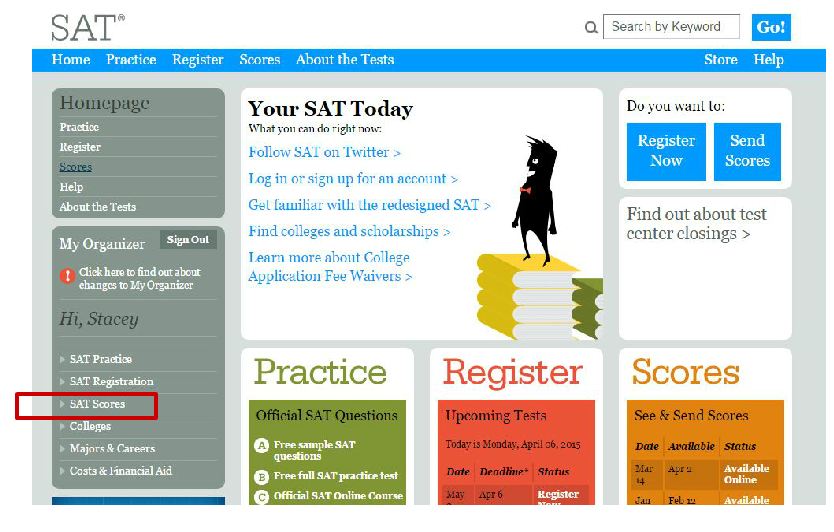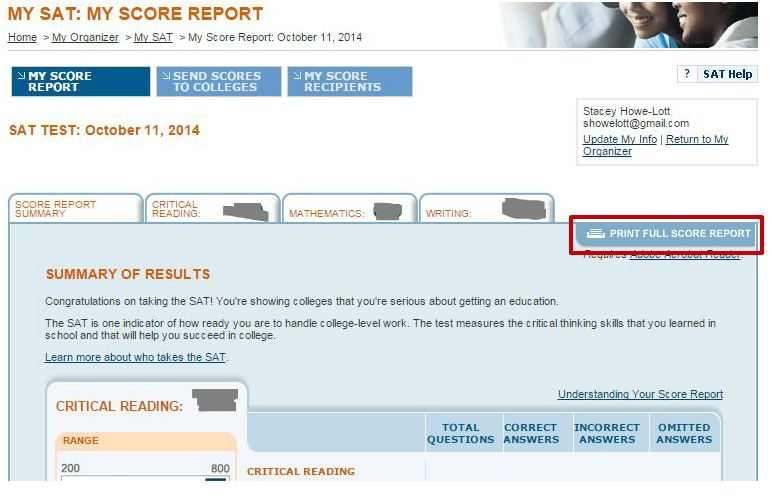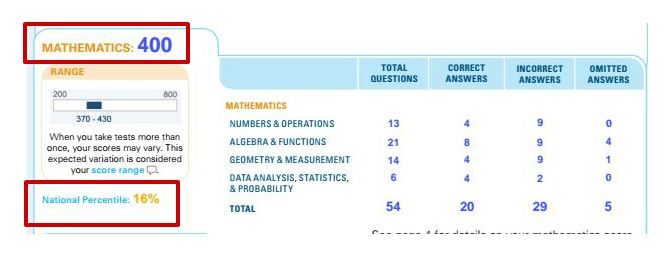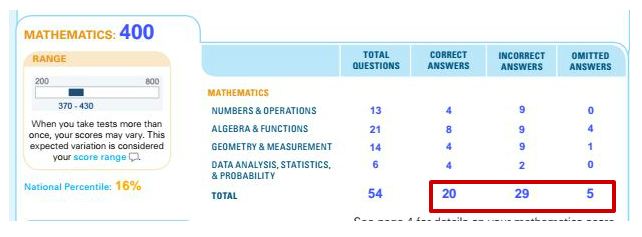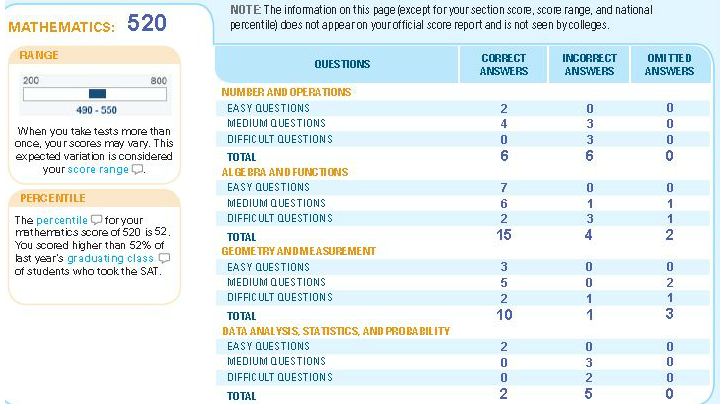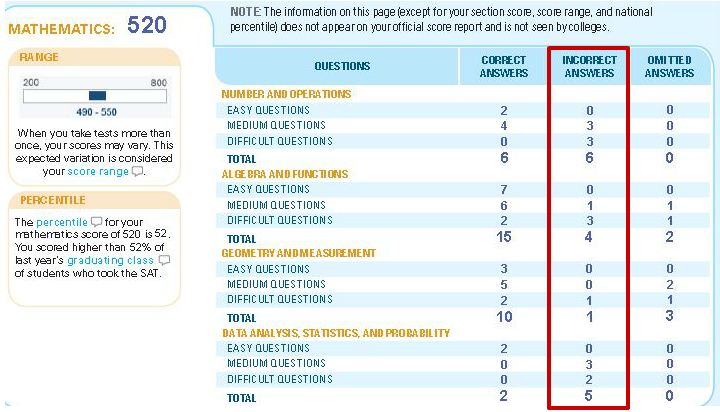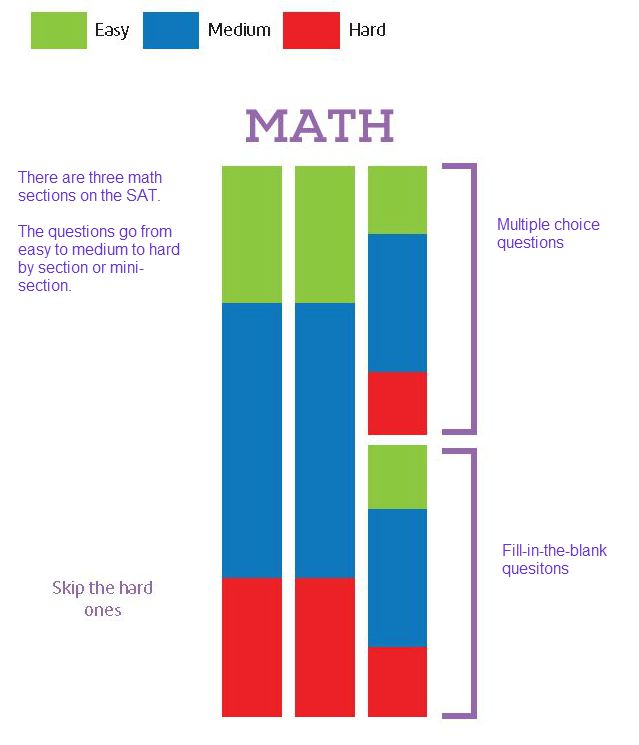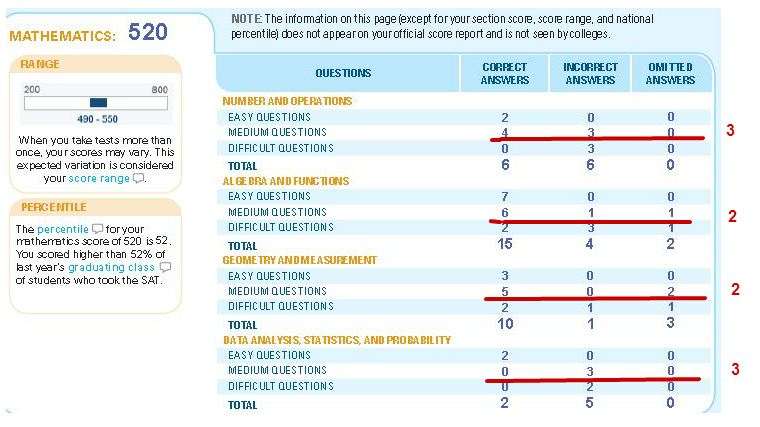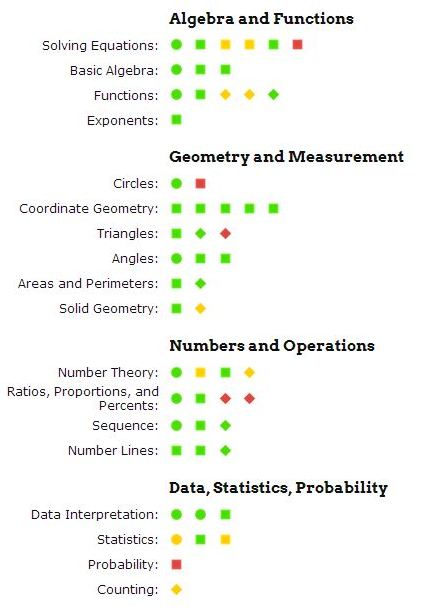[Note: this refers to the old version of the SAT. I’m working a new post that shows how to analyze the College Board’s Score Report for the new SAT.]
Here are 5 steps to take to get the most out of the College Board’s Full Score Report.
Step 1: Download the SAT Score Report
If you haven’t already done so, download the report. Here’s how:
1. Log into the College Board site
2. Click on the SAT Scores link
3. Click on the Understand Your Test Performance link
4. Click on the Print Full Score Report button
Step 2: Look at the scaled score and percentile score
Start with the Summary of Results on the first page.
Look at both the top level number score and the percentile score. The percentile score will give you more of an intuitive sense of where you are compared to everyone else.
Key questions to ask yourself:
- How far am I from my target score? (You have a target score, right?)
- What do I need to do differently in order to gain those points?
(It’s okay if you don’t yet know the answer to this question. You will by the end of this analysis.)
Step 3: Look at the total number of correct, incorrect, and omitted answers
Too many wrong questions
Remember how the SAT is scored – 1 point for each right answer, -1/4 point for every incorrect answer, and no penalty for omitted answers. So this kid scored 20 points for right answers minus 7.25 for incorrect answers for a raw score of 13 (the SAT rounds up) which translated into a scaled score of 400.
Don’t let that measly little 7.25 fool you. It’s not as innocuous as it seems. Roughly speaking, every raw point translates into about 10 points in the scaled score.
He lost 70 points through his incorrect answers!
What if he had skipped just half of those incorrect answers? I know is a little bit of a mind game – since if he knew he was going to get it wrong he wouldn’t have answered it.
But I would argue that he did know he wasn’t in a good guessing position on most of those questions. Wildly guessing hurts you on the SAT but educated guessing helps!
So if he had only guessed on half of those questions, and skipped the other half – he would have gained 40 more points. By answering fewer questions!
And this hypothetical score increase would probably be larger than that – because he could have used all that time he saved by skipping those questions to spend more time on other questions and probably gotten several more right. (Another student jumped up 140 points just by skipping more questions.)
For the vast majority of students this holds true:
Answer fewer questions and get a higher score.
Too many skipped questions
Unless your score report looks something like this:
This student only has 4 wrong answers. I like my students to only miss about 4 to 8 questions- that means they’re being aggressive but not wildly guessing.
This student really can’t improve by answering fewer questions – she only lost 1 point for those 4 wrong answers. The only way for her to improve her scores is to answer more questions.
Key questions to ask yourself:
- Do I have too many incorrect answers?
- Do I have too many omitted answers?
- What new strategies can I use to gain more points?
Step 4: Analyze the Score Details section
This is where you can really dig into your answers to see a more detailed analysis of your results. These pages show you the breakdown of the questions by topic and difficulty level.
This student had 33 questions correct, 16 incorrect, and omitted 5.
We already know how to figure out what those 16 incorrect answers cost her – she lost 4 points off her raw score which is about 40 points off her scaled score.
If she was going to answer fewer questions next time around, which questions should she skip?
While you may get more brownie points in heaven for answering hard questions, the SAT folks don’t give you any more points for answering the hard questions correctly. Remember that all questions are worth one point.
Let me say that again: all questions are worth one point. Most of my students know this, but they don’t realize the implications of it.
If your goal is to rack up the highest number of points, wouldn’t it make sense to answer more of the ones you are more likely to get right and fewer of the ones you are more likely to get wrong?
Incorrect answers by level of difficulty
Let’s look at the incorrect answers more closely. This student missed 7 medium questions and 9 hard questions.
Of the difficult questions she answered, she got 4 correct and 9 incorrect – for a net of 2 points (4 points for the correct answer minus 2 points for the incorrect = 2 points).
Let’s say she skipped the hard questions entirely – so she’d lose those two points. Could she make it back by spending that time on the 10 medium questions that she missed and omitted?
My guess is that should would earn more than 2 raw points – in fact she’d probably earn closer to 5 raw points. She’d be working on easier questions so she’s got a higher likelihood of getting them right. She’d be taking more time on them which also means she’s more likely to get them correct.
(My students usually increase their scores 50 to 100 points overnight just by skipping hard questions.)
So where are those hard questions hiding?
If only we knew where the hard questions were hanging out so we could avoid them!
Luckily, in the math section (and in the writing section, and to a limited extent in the reading section) we know EXACTLY where the hard questions are hiding out.
In my experience, most kids make MASSIVE score improvements by doing this one thing:
Skip the hard questions.
Incorrect answers by topic
There’s one more way we can analyze these answers – by topic. Let’s look at the incorrect and omitted medium questions by topic.
Initially you might look at these results and think that this student should work on either Numbers and Operations or Data Analysis, Statistics, and Probability since she missed three questions each in those topics.
But this report visually is a little misleading. It looks like all the topics are tested equally – but they aren’t. If you sum up the total questions for each topic you can see that:
| Questions | Percentage | ||
| Numbers and Operations | 12 | 22% | |
| Algebra and Function | 21 | 39% | |
| Geometry and Measurement | 14 | 26% | |
| Data Analysis, Statistics, and Probability | 7 | 13% |
It’s even more eye-opening when you look at the sub-topics under each main topic. (I’ll get to that issue in a minute.) In the meantime, here’s a breakdown of which topics show up more frequently in the math (and critical reading and writing) section in all of the tests in the Official SAT Study Guide.
So I’d suggest to this student that she focus on the 2 questions she missed and skipped in the Algebra and Functions topic area- they are almost twice as likely to show up as Numbers and Operations questions and three times as likely to show up as Data Analysis, Statistics and Probability questions – and the 2 questions she missed and skipped in the Geometry and Measurement topic area- again, they are much more likely to show up on the next test than the other types of questions.
Of course, “Algebra and Functions” is a pretty big topic area. I wonder if she missed a function question? Or was it an exponent question? Or maybe it was a basic algebra word problem? Where should she focus her limited time and energy to get the biggest bang for her buck?
We need better reports
It would be a lot more useful if students could see their performance by topic, not just the broad topic area. Then they could see exactly what they needed to study in order to increase their SAT score.
I’ve created detailed reports for all the tests in the Official SAT Study Guide.
But back to getting the most of the College Board’s score report.
Key questions to ask yourself
- How many medium questions did you miss or skip?
- How many hard questions did you miss or skip?
- Which topic areas do you need to study?
Step 5: Create your new strategy
You should now have a handle on some specific actions you can take to increase your SAT score.
As my students have proven time and time again, smart, motivated students + the right SAT strategies to maximize their strengths and minimize their weaknesses can result in amazing SAT scores.
Key questions to ask yourself
- What new strategies are you going to use to increase your SAT score?
- What do you need to do between now and the next SAT to make sure you’ll hit your target score?
If you need help
If you need help sorting through your score report and designing a better strategy for yourself, email it to me. I’d be happy to look it over and provide some suggestions on what you could do to improve your SAT scores- at no cost or obligation.
